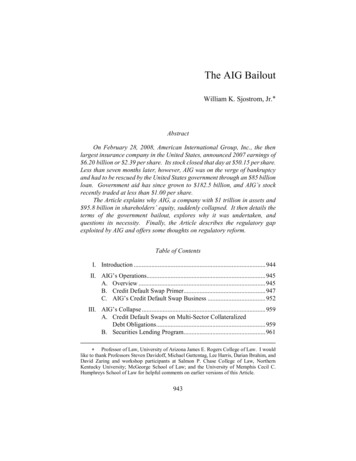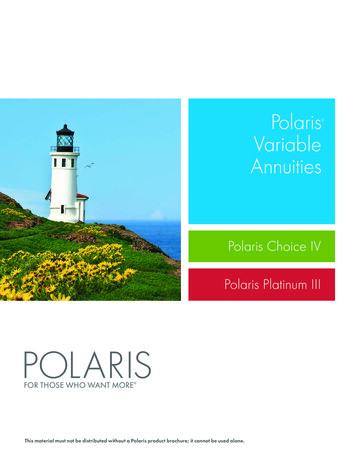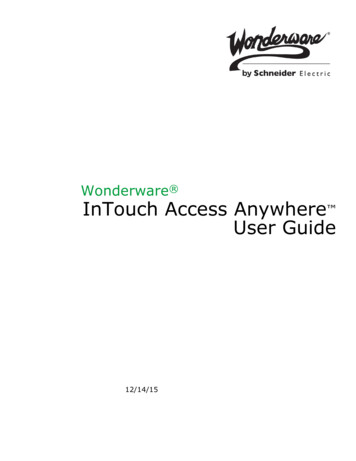
Transcription
The AIG BailoutWilliam K. Sjostrom, Jr. AbstractOn February 28, 2008, American International Group, Inc., the thenlargest insurance company in the United States, announced 2007 earnings of 6.20 billion or 2.39 per share. Its stock closed that day at 50.15 per share.Less than seven months later, however, AIG was on the verge of bankruptcyand had to be rescued by the United States government through an 85 billionloan. Government aid has since grown to 182.5 billion, and AIG’s stockrecently traded at less than 1.00 per share.The Article explains why AIG, a company with 1 trillion in assets and 95.8 billion in shareholders’ equity, suddenly collapsed. It then details theterms of the government bailout, explores why it was undertaken, andquestions its necessity. Finally, the Article describes the regulatory gapexploited by AIG and offers some thoughts on regulatory reform.Table of ContentsI. Introduction . 944II. AIG’s Operations. 945A. Overview . 945B. Credit Default Swap Primer. 947C. AIG’s Credit Default Swap Business . 952III. AIG’s Collapse . 959A. Credit Default Swaps on Multi-Sector CollateralizedDebt Obligations . 959B. Securities Lending Program. 961 Professor of Law, University of Arizona James E. Rogers College of Law. I wouldlike to thank Professors Steven Davidoff, Michael Guttentag, Lee Harris, Darian Ibrahim, andDavid Zaring and workshop participants at Salmon P. Chase College of Law, NorthernKentucky University; McGeorge School of Law; and the University of Memphis Cecil C.Humphreys School of Law for helpful comments on earlier versions of this Article.943
94466 WASH. & LEE L. REV. 943 (2009)C. Inability to Access Capital Markets and CreditDowngrade . 962IV. The Bailout . 963A. Initial Bailout . 964B. Additional Lifelines . 968C. Bailout Restructuring I . 969D. Bailout Restructuring II . 972E. Grand Total. 974F. Legal Issues . 976G. Why the Bailout? . 977V. The (Lack of) Regulation of Credit Default Swaps . 983A. Regulatory Gap . 983B. Regulatory Reform . 989VI. Conclusion . 990I. IntroductionOn February 28, 2008, American International Group, Inc. (AIG), then thelargest insurance company in the United States,1 announced 2007 earnings of 6.20 billion or 2.39 per share.2 Its stock closed that day at 50.15 per share.3Less than seven months later, however, AIG was on the verge of bankruptcyand had to be rescued by the United States government through an 85 billion1. Based on net premiums underwritten, AIG was the largest life insurer, the largesthealth insurer, and the second largest property and casualty insurer in the U.S. AmericanInternational Group: Examining What Went Wrong, Government Intervention, andImplications for Future Regulation: Hearing Before S. Comm. on Banking, Housing & UrbanAffairs, 111th Cong. 1–2 (2009) (statement of Donald L. Kohn, Vice Chairman, Board ofGovernors of the Federal Reserve System) [hereinafter Kohn Statement], available athttp://banking.senate.gov/ public/ files/KohnStmtMarch52009.pdf.2. Press Release, American International Group, Inc., AIG Reports Full Year and FourthQuarter 2007 Results (Feb. 28, 2008), available at 5012308002282/y50505exv99w1.htm.3. Yahoo! Finance, AIG: Historical Prices for American International Group, Inc.,http://finance.yahoo.com/q/hp?s AIG (last visited Sept. 29, 2009) (on file with the Washingtonand Lee Law Review).
THE AIG BAILOUT945loan.4 Government aid has since grown to 182.5 billion,5 and as recently asJune 2009 AIG’s stock traded at less than 1.00 per share.6AIG’s collapse was caused largely by its 526 billion portfolio of creditdefault swaps (CDSs), a type of credit derivative widely used by financialinstitutions but, up until recently, largely unknown by the general public.7AIG’s troubles have been covered extensively by the media but are difficult tocomprehend fully because of the esoteric financial instruments involved. Thus,this Article weaves explanations of CDSs, asset-backed securities,securitization, tranching, and collateralized debt obligations into a detailed andsystematic account and analysis of what went wrong at AIG and why thegovernment bailed it out. A thorough understanding of these events isimportant because of the unprecedented size of the bailout and attendant callsfor increased regulation of CDSs.Part II provides a brief overview of AIG’s operations, a primer on CDSs,and analysis of AIG’s CDS activities. Part III explains how AIG’s CDSbusiness pushed it to the brink of bankruptcy by draining it of cash. Part IVdetails the terms of the government bailout (including its two restructurings),explores why it was undertaken, and questions its necessity. Part V describesthe regulatory gap exploited by AIG and offers some thoughts on regulatoryreform.II. AIG’s OperationsA. OverviewAIG is "a holding company which, through its subsidiaries, is engaged in abroad range of insurance and insurance-related activities in the United Statesand abroad."8 It is incorporated in Delaware,9 and its common stock is listed onthe New York Stock Exchange.10 AIG has operations in more than 130countries with about half of its revenues derived from its foreign operations.114. Infra Parts III & IV.5. Infra Part IV.E.6. Yahoo! Finance, supra note 3.7. Infra Part III.A.8. AIG, 2007 Annual Report (Form 10-K), at 3 (Feb. 27, 2008) [hereinafter AIG ‘07Annual Report], available at 5012308002280/y44393e10vk.htm.9. Id.10. Id. at 26.11. Moody’s Investors Service, Company Profile: American International Group, Inc. 1
94666 WASH. & LEE L. REV. 943 (2009)Its principal business units are General Insurance, Life Insurance & RetirementServices, Financial Services, and Asset Management.12 The General Insuranceunit underwrites commercial property, casualty, workers’ compensation, andmortgage guarantee insurance.13 The Life & Retirement Service unit providesindividual and group life, payout annuities, endowment, and accident andhealth insurance policies.14 The Financial Services unit engages in aircraft andequipment leasing, capital market transactions (including CDS transactions),consumer finance, and insurance premium finance.15 The Asset Managementunit offers a wide variety of investment-related services and investmentproducts to individuals, pension funds, and institutions.16 AIG ranked tenth inthe 2007 Fortune 50017 and twenty-third in the 2007 Global 500.18 As ofDecember 31, 2007, AIG had total assets of 1.06 trillion,19 shareholders’equity of 95.8 billion, and a market capitalization of 150.7 billion.20The following table summarizes AIG’s operating performance by unit forthe years ended December 31, 2005, 2006, and 2007, and the nine monthsended September 30, 2008:21(Jan. 2008).12. AIG ‘07 Annual Report, supra note 8, at 3.13. Id. at 6.14. Id. at 10.15. Id. at 11.16. Id.17. See Largest U.S. Corporations, FORTUNE, Apr. 3, 2007, at 210 (showing that in 2006AIG generated the tenth most revenues among U.S. public companies).18. World’s Largest Corporations, FORTUNE, July 23, 2007, at 133. This means that in2006 AIG generated the twenty-third most revenues among all public companies in the world.19. AIG ‘07 Annual Report, supra note 8, at 28.20. This number is based on a closing price of 58.30 per share on December 31, 2007,and outstanding shares of 2,585,000,000. Id. at 13.21. Id. at 36; see also AIG, Quarterly Report (Form 10-Q), at 12 (Nov. 10, 2008)[hereinafter AIG September ‘08 Quarterly Report], available at 5012308014821/y72212e10vq (providing part of this data).
THE AIG BAILOUT947NineMonthsEnded9/30/08(In Millions)RevenuesGeneral InsuranceLife Insurance &RetirementFinancial ServicesAsset ManagementOtherConsolidation &EliminationsTotalOperating Income(Loss)General InsuranceLife Insurance &RetirementFinancial ServicesAsset ManagementOtherConsolidation &EliminationsTotal 20072006200535,85414,271 51,70853,570 49,20650,878 7774,54348350010,6774,582344(16) 34,862 110,064 113,387 108,781 (393)(19,561) 10,5628,186 10,41210,121 140)722 (48,205) 8,9433831,538(1,435)668 21,6874,4241,963(2,765)311 15,213B. Credit Default Swap PrimerAs is obvious from the above table, AIG had some major problems withinits Financial Services unit in 2007 and 2008. The staggering 32.4 billion inlosses the unit racked up from January 2007 through September 2008 stemalmost entirely from the unit’s CDS activities. Because, as discussed in Part IIIbelow, these activities are at the heart of AIG’s collapse,22 this section providesa primer on CDSs.A CDS is a privately negotiated contract where one party (the "protectionseller"), in exchange for a fee, agrees to compensate another party (the"protection buyer") if a specified "credit event" (such as bankruptcy or failure22. See Monica Langley et al., Bad Bets and Cash Crunch Pushed Ailing AIG to Brink,WALL ST. J., Sept. 18, 2008, at A1 (noting that "[t]he rot stemmed largely from losses in a unitthat sold a complex kind of derivative, called a credit-default swap, designed to protect investorsagainst default in an array of assets, including subprime mortgages").
94866 WASH. & LEE L. REV. 943 (2009)to pay)23 occurs with respect to a company (the "reference entity") or debtobligation (the "reference obligation").24 CDSs are used for a variety ofpurposes including hedging, speculation, and arbitrage.25For example, if a mutual fund wants to hedge its credit risk exposure on its 100 million of XYZ Inc. (XYZ) bonds that mature in five years, it can do so byentering into a five-year, 100 million CDS with a protection seller. The CDSwould designate XYZ as the reference entity and XYZ’s bonds as the referenceobligation. It would define credit event as XYZ’s bankruptcy or paymentdefault on its bonds. In this example, the CDS would have a "notional amount"of 100 million because that is the amount of protection provided by theCDS.26 In connection with writing the CDS, the protection seller would assessthe likelihood of a credit event occurring during the next five years and set itsfee for providing the protection accordingly.27 This fee is referred to as theCDS spread or premium and is expressed in basis points28 per annum on thenotional amount of the CDS.29 The spread is typically payable quarterly.30 Inthis example, if the protection seller sets the spread at 100 basis points, the fund23. U.S. GOV’T ACCOUNTABILITY OFFICE, GAO-07-716, CREDIT DERIVATIVES:CONFIRMATION BACKLOGS INCREASED DEALERS’ OPERATIONAL RISKS, BUT WERE SUCCESSFULLYADDRESSED AFTER JOINT REGULATORY ACTION 5 n.6 (2007) [hereinafter GAO REPORT],available at http://www.gao.gov/new.items/d07716.pdf.24. Nomura Fixed Income Research, Credit Default Swap (CDS) Primer 1, 1, May 12,2004, [hereinafter CDS Primer], available at imer.pdf; seealso GAO REPORT, supra note 23, at 5. Other types of CDSs include multi-name, whichreference more than one corporate or sovereign entity, and index, which are based on an indexof corporate entities. Systemic Risk: Regulatory Oversight and Recent Initiatives to AddressRisk Posed by Credit Default Swaps: Hearing Before the Subcomm. on Capital Markets,Insurance, and Government Sponsored Enterprises of the H. Comm. on Financial Servs., 111thCong. 4 (2009) (statement of Orice M. Williams, Director, Financial Markets and CommunityInvestment, U.S. Gov’t Accountability Office) [hereinafter Williams Statement], available athttp://www.gao.gov/new.items/d09397t.pdf.25. See Frank Partnoy & David A. Skeel, Jr., The Promise and Perils of CreditDerivatives, 75 U. CIN. L. REV. 1019, 1022 (2007) (listing the uses of CDSs).26. See Arvind Rajan, A Primer on Credit Default Swaps, in THE STRUCTURED CREDITHANDBOOK 17, 23 (Arvind Rajan et al. eds., 2007) (defining notional amount as "the amount ofexposure to a particular credit (the reference entity) for which protection is being either boughtor sold for a particular period of time").27. See CDS Primer, supra note 24, at 4 (noting that CDS pricing involves assessing"(1) the likelihood of default, (2) the recovery rate when default occurs, and (3) someconsideration for liquidity, regulatory, and market sentiment about the credit").28. A basis point equals 0.01% (1/100th of a percent) or 0.0001 in decimal form.29. CDS Primer, supra note 24, at 3.30. See Rajan, supra note 26, at 23 (noting that protection buyers, at least according toU.S. market convention, typically "pay quarterly on an Actual/360 basis").
THE AIG BAILOUT949would pay the protection seller 250,000 per quarter during the five-year termof the CDS.31If no credit event occurs during the term of a CDS, the protection sellerretains the premium payments and the parties go their separate ways.32 In thisexample, that means the protection seller would have grossed 5 million fromwriting the CDS ( 250,000 per quarter multiplied by twenty quarters). If acredit event does occur during the CDS term, the protection seller is thenobligated to compensate the protection buyer. Compensation occurs througheither physical or cash settlement, depending on what the CDS specifies.33 Ifthe CDS provides for physical settlement, it will specify types of "deliverableobligations" that the protection seller is required to buy for par (full face value)upon delivery by the protection seller.34 In this example, assume the CDSprovided for physical settlement and designated the XYZ bonds as thedeliverable obligation. Following an XYZ credit event, the fund would transferthe 100 million face amount of XYZ bonds to the protection seller. Theprotection seller would then pay the fund 100 million, and the CDS wouldterminate.35 Obviously, XYZ bonds will have dropped in value as a result ofthe credit event and, therefore, will be worth much less than par.If the CDS provides for cash settlement, the parties agree on a marketvalue for the reference obligation.36 The protection seller then pays theprotection buyer the difference between the market value and the par value ofthe reference obligation.37 In this example, assume that the market value of the31. The calculation is as follows: 100 million notional amount multiplied by 1% dividedby 4 (number of quarters in a year).32. See Rajan, supra note 26, at 23 ("If no credit events occur during the term of thedefault swap, the swap expires unexercised.").33. CDS Primer, supra note 24, at 4.34. Id. at 5.35. The CDS contract would specify the types and characteristics of XYZ debt that can beused to fulfill the deliverable obligation. See Rajan, supra note 26, at 24 ("[Deliverableobligations] are obligations of the reference entity that may be delivered, per the CDS contract,in connection with physical settlement . . . . [I]n the most common versions of CDS, thedeliverable obligation must be pari passu with senior unsecured obligations of the referenceentity."); see also ANTULIO N. BOMFIN, UNDERSTANDING CREDIT DERIVATIVES AND RELATEDINSTRUMENTS, at 69 (2005).36. See Rajan, supra note 26, at 24 ("If the contract is cash settled, a market value isdetermined for the reference obligation and the protection seller makes a cash payment to theprotection buyer for the implied loss on that obligation."); see also BOMFIN, supra note 35, at292 ("The market value of the reference obligation is commonly determined by a dealer polltypically conducted a few days after the credit event.").37. See Rajan, supra note 26, at 24 ("[T]he protection seller pays the buyerN 100 R , where R is the price of the reference security after the credit event (recoveryvalue) and N is the notional amount.").()
95066 WASH. & LEE L. REV. 943 (2009)reference obligation dropped to 25% of par following the credit event. Theprotection seller would then pay the fund 75 million ( 100 million par valueless the 25 million market value) and the CDS would terminate.38In addition to hedging, CDSs can be used to speculate on a change in acompany’s credit quality. For example, if a hedge fund believed that XYZ’scredit quality was going to deteriorate within the next two years, it could thenbuy a three-year 50 million notional amount 200 basis point cash-settled XYZCDS. Suppose XYZ suffers a credit event a year later and the CDS referenceobligation drops to 20% of par. The hedge fund will have grossed 39 millionon the transaction ( 40 million cash payment from the protection seller less the 1 million CDS premium the hedge fund paid for the year). Alternatively, ifXYZ’s credit quality drops significantly a year later but not to the point where acredit event occurs, the spread that parties would be willing to pay on XYZCDSs might widen to 700 basis points. If the hedge fund believes XYZ’scredit quality is likely to improve over the next two years, it could lock in aprofit by selling a two-year 50 million notional amount 700 basis point cashsettled XYZ CDS.39 If, as expected, no credit event occurs during the next twoyears, the hedge fund will have paid 2 million on the XYZ CDS it bought butwill have received 7 million on the CDS it sold, netting 5 million on the twotransactions.Further, CDSs can be used for arbitrage. Arbitrage techniques includebuying or selling a debt security and simultaneously buying or selling a CDS onthe debt security. The idea is to earn a credit-risk-free return by capturing atemporary mispricing between the debt security and CDS spread.40A prominent risk inherent in a CDS faced by a protection buyer, whetherengaging in hedging, speculation, or arbitrage, is counterparty credit risk.41Counterparty credit risk is the risk that a protection seller will be unable orunwilling to make the payment due under a CDS following a credit event.42 Toaddress counterparty credit risk, a CDS may require the protection seller to postcollateral with the protection buyer equal to a specified percentage of the38. See id. (noting the termination of the swap upon cash settlement).39. Alternatively, the hedge fund could agree to terminate the CDS in exchange forpayment from the protection seller reflecting the change in value or could assign the CDS to athird party in exchange for a fee. BOMFIN, supra note 35, at 70.40. MOORAD CHOUDHRY, THE CREDIT DEFAULT SWAP BASIS 116 (2006).41. BOMFIN, supra note 35, at 10.42. See COUNTERPARTY RISK MGMT. POLICY GROUP II, TOWARD GREATER FINANCIALSTABILITY:A PRIVATE SECTOR PERSPECTIVE 110 (July 27, 2005), available athttp://w
The AIG Bailout William K. Sjostrom, Jr. Abstract On February 28, 2008, American International Group, Inc., the then largest insurance company in the United States, announced 2007 earnings of 6.20 billion or 2.39 per share. Its stock closed that day at 50.15 per share. Less than seven months later, how











